
Have you ever been confused by other people’s body language on a trip abroad? Have you perhaps caused a few raised eyebrows yourself by using a hand gesture that was interpreted in an unexpected way? While there is a lot of overlap in how different physical gestures and expressions are interpreted around the world, there are also many cultural differences. Therefore, it’s always a good idea to do a bit of research if you’re planning to travel to a new country, including Finland!
Of course, avoiding inadvertently offending someone is not the only benefit of learning Finnish hand gestures and body postures. You’ll also be able to communicate more effectively with Finnish people and feel more confident, whatever level your verbal language skills are currently at.
But wait! Aren’t Finns famous for their deadpan humor and reserved manner? It’s true that Finns rarely get excessively animated, but Finnish body language is definitely a thing. And you can also expect Finns to notice and pay attention to your body language when you’re communicating with them!
Nonverbal communication is a topic that’s rarely taught in language classes, so we’re here to help with that. We’ll look at some common Finnish hand gestures, facial expressions, and body postures that you can start practicing right away.
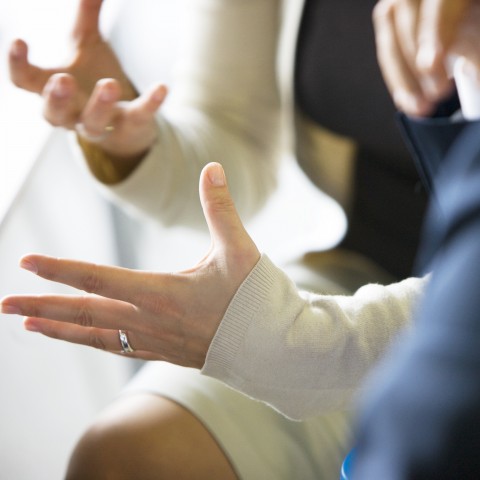
Hand gestures add a lot of depth to conversations.
- Are you already fluent in (verbal) Finnish? Then check out a fascinating article and video about cultural differences in body language.
 Table of Contents
Table of Contents
- Basic Gestures
- Hand Gestures
- Facial Expressions
- Body Postures
- FinnishPod101 Can Help You Learn Finnish Faster
1. Basic Gestures
Let’s start with the essentials! These are the Finnish greetings and gestures that you’ll use the most when you meet and interact with Finnish people.
1 – Kädenheilautus (“Hand wave”)
| Meaning: | “Hi.” / “Bye.” |
| How: | Move a raised hand from side to side with your palm facing the person you’re greeting. |
| Where / When: | A hand wave is an informal greeting that’s often used when you greet a friend from a distance or are greeting several people at the same time. A hand wave can also be used when you’re trying to get someone’s attention (in a casual setting) or when you’re saying goodbye to people. |

Voit tervehtiä ystäviäsi käden heilautuksella. (“You can greet your friends with a hand wave.”)
2 – Kättely (“Handshake”)
| Meaning: | “Hello.” / “Nice to meet you.” / “Let’s shake on it.” |
| How: | A typical Finnish handshake is firm and brief. It’s customary to look the other person in the eye and say your preferred greeting—or your name, if you’re meeting someone for the first time—when you shake hands. |
| Where / When: | In Finland, shaking hands is a very common way to greet anyone from friends to colleagues in both formal and informal situations. A handshake is also commonly used when making an agreement with someone or when making up after a disagreement. There’s been a lively discussion going on in Finland about the pros and cons of shaking hands, and whether Finns as a nation should break with tradition and start favoring other ways of greeting people. Younger generations are increasingly using alternatives like rystystervehdys (“fist bump”) and ylävitonen (“high five”) to greet their peers. Hugging in Finland is limited to interactions between family members and close friends. |
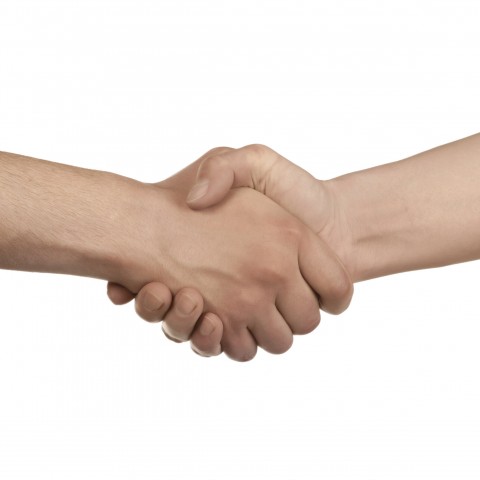
kätellä (“to shake hands”)
- Learn all about how to greet a Finn with confidence in this Basic Finnish Greetings audio lesson on FinnishPod101.com, or visit our blog for an in-depth guide to Finnish Greetings.
3 – Nyökkäys (“Nod”)
| Meaning: | “Yes” |
| How: | Lift and drop your chin while maintaining eye contact. |
| Where / When: | In Finland, nodding your head signals “yes.” You can also nod your head while listening to someone to show that you’re paying attention and following what they’re saying. Finally, nodding is often used as an alternative way of greeting someone. |
4 – Päänpudistus (“Head shake”)
| Meaning: | “No” |
| How: | Move your head from side to side while maintaining eye contact. |
| Where / When: | In Finland, shaking your head means “no.” You can also shake your head to signal disbelief or disagreement with what somebody is saying. |
2. Hand Gestures
Let’s move on to hand gestures used in Finland.
5 – Peukku ylös (“Thumbs-up”)
| Meaning: | “Good.” / “Everything is okay.” / “I agree.” / “Good luck.” |
| How: | Make a fist with your hand and raise your thumb. You can do this gesture with one or both hands. |
| Where / When: | In Finland, the thumbs-up gesture can mean a few different things, all of them positive. For example, you can signal with an upturned thumb that things are good, or that you agree with or approve of something. Finns also use raised thumbs to wish somebody good luck. The phrase pitää peukkuja (literally: “to hold thumbs”) is equivalent to “crossing one’s fingers” for luck, which is also used in Finnish (called pitää sormet ristissä). There are a few phrases you can say alongside this gesture when you want to wish someone good luck:
|

Onnea! (“Good luck!”)
- Now you know that peukku (colloquial) or peukalo means “thumb” in Finnish. Why not learn the names of other body parts in Finnish, too?
6 – Pirunsarvet (“The horns”)
| Meaning: | Associated with heavy metal music |
| How: | Raise your little finger and index finger while holding the other two fingers down with your thumb. |
| Where / When: | Heavy metal music is huge in Finland, and the fans of the genre use the horn gesture to show their appreciation for artists at gigs and concerts. If you’re wondering how the horns became associated with heavy metal, visit the Drooble blog for a fun bite of pop culture history. |

The “horns” gesture is frequently seen at heavy metal concerts in Finland.
7 – Keskisormi or Keskari (“Middle finger”)
| Meaning: | An offensive gesture |
| How: | Raise the middle finger with the other fingers held down. |
| Where / When: | This is the most common of the offensive gestures used in Finland. The intention behind the gesture is usually to tell another person to go and smell something offensive. The Finnish verb haistatella (“to tell someone where to go”) is derived from the verb haistaa (“to smell”). |
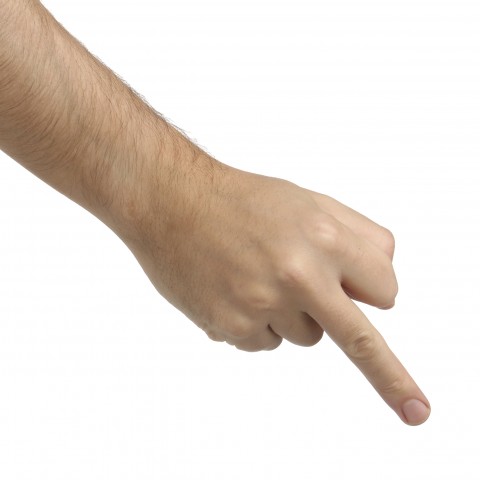
Showing the middle finger in Finland could get you into trouble.
- Instead of raising your middle finger, try one of these Finnish phrases to use when you’re angry!
8 – Hys (“Shush”)
| Meaning: | “Keep quiet.” |
| How: | Hold your raised index finger vertically against your lips and make eye contact. You can also make the ‘shh’ sound. |
| Where / When: | This gesture will be familiar to people from many different countries. In Finland, you’re most likely to come across it in places like libraries and cinemas! |
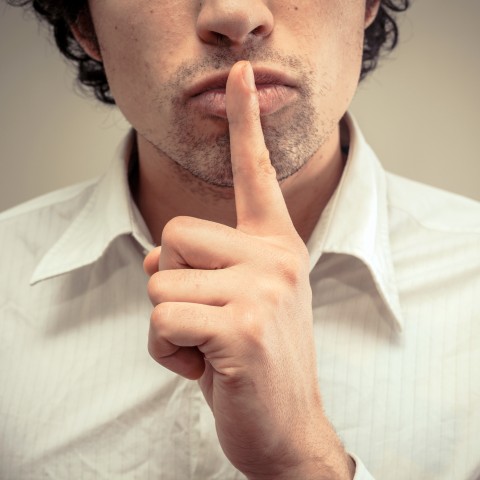
Hys. Ole hiljaa. (“Shush. Be quiet.”)
9 – Pälä-pälä-pälä (“Blah blah blah”)
| Meaning: | “Not interested.” / “Whatever.” |
| How: | Keep your fingers together and touch them repeatedly against your thumb, imitating a talking mouth. |
| Where / When: | This gesture signals that you think someone is speaking too much or that you couldn’t care less about what they’re saying. Unsurprisingly, it’s an impolite gesture to use! |
10 – Mennä yli hilseen (“To go over one’s head”)
| Meaning: | “I don’t get it.” / “I don’t understand what you’re saying.” |
| How: | Make a swift swiping motion with a flat hand over your head. |
| Where / When: | This gesture is used to signal that you’re completely mystified about what someone is saying. Note that hilse means “dandruff”; Finns say that a thing “goes over the dandruff” when they don’t understand something! |
This gesture also exists in the Finnish sign language. Visit the Finnish Signbank to view a short video clip of the gesture.
11 – Käsien hierominen yhteen (“Rubbing one’s hands together”)
| Meaning: | “I’m looking forward to this.” |
| How: | Rub your palms and fingers together with your hands aligned. |
| Where / When: | It’s possible that you’ll see someone rubbing their hands together simply to warm them up. However, as a gesture, rubbing hands together typically means that you’re anticipating something pleasant or about to do something that you’re excited about, such as eating a delicious korvapuusti (“cinnamon roll”) with a cup of coffee! |
3. Facial Expressions
While the Finnish racing driver Kimi “The Iceman” Räikkönen is famous for his terse and expressionless communication style, you can expect more expressiveness from the average Finn. Here are some facial expressions typical of Finnish communication!
12 – Silmänisku (“Wink”)
| Meaning: | Flirtation. A shared secret. |
| How: | Close one eye briefly while keeping the other eye open and maintaining eye contact. A wink is usually accompanied by a smile. |
| Where / When: | Finns aren’t overly flirtatious people, but a wink can signal attraction and interest in another person. A wink between people who know each other can also signal awareness of a shared secret. |

Iskeä silmää (“To wink”)
13 – Silmien pyöritys (“Eye roll”)
| Meaning: | “You can’t be serious.” |
| How: | Roll your eyes up and down in a circular motion. |
| Where / When: | Rolling one’s eyes signals exasperation, disbelief, or boredom. Again, not a polite expression! |

Et voi olla tosissasi. (“You can’t be serious.”)
14 – Kielen näyttäminen (“Poking one’s tongue out”)
| Meaning: | Teasing. Playfulness. |
| How: | Extend your tongue out of your mouth. The chin is often lifted at the same time. |
| Where / When: | This is a gesture that’s associated especially with children! However, adults can also signal irreverence and playfulness by poking their tongue out. Don’t be surprised if you see this expression in many selfies taken by teens and young adults! |

Lapsi näyttää kieltä. (“A child pokes her tongue out.”)
4. Body Postures
Body postures are another crucial component of Finnish body language. Here are some stances and movements you should be aware of!
15 – Kädet lanteilla (“Hands on hips”)
| Meaning: | Confidence. Dominance. |
| How: | Place your hands on your hips with your elbows pointing outwards. |
| Where / When: | This is a posture that not only signals confidence to those around you, but it can actually help you feel more confident too, especially if you also puff your chest out a little and keep your feet about a hip-width apart. |
16 – Kädet puuskassa (“Arms crossed”)
| Meaning: | Various meanings, for example uncertainty and defensiveness. |
| How: | Cross your arms in front of your body. |
| Where / When: | Apparently, there are more than 50 different types of arm crosses, so this one is not a completely straightforward posture to interpret in social situations. For example, it could be a self-soothing posture for someone who feels insecure, or it could come across as standoffish. However, the rumor that crossing your arms is considered extremely arrogant and is likely to get you into a fight with Finns is not true. Raising your middle finger is far more likely to provoke an angry reaction in Finland than crossing your arms in front of your body! |

Crossing your arms can come across as standoffish depending on the rest of your body language.
17 – Käsi sydämellä (“Hand on heart”)
| Meaning: | Sincerity. Empathy. |
| How: | Place an open palm on your chest over your heart. |
| Where / When: | This gesture signals to your conversation partner that you’re being sincere or are feeling empathy toward them. You’ll see it used in personal interactions rather than at the workplace. |
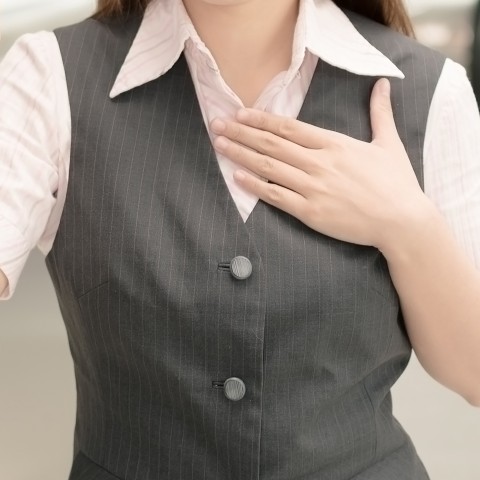
Käsi sydämellä (“Hand on heart”)
18 – Nostettu kämmen (“Raised palm”)
| Meaning: | “Stop.” / “Wait.” / “Don’t come closer.” |
| How: | Raise your arm with your open palm facing outwards. |
| Where / When: | This posture simply signals that you should stop and wait, possibly because it’s not safe to approach. It’s not in itself an offensive posture like in some other cultures, though it can be seen as harsh depending on the situation. |
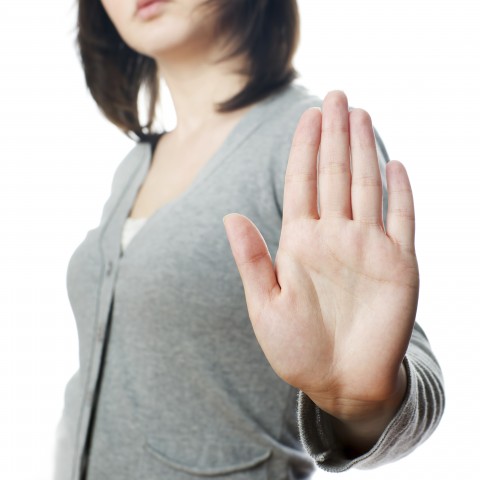
Pysähdy, älä tule lähemmäs. (“Stop, don’t come closer.”)
19 – Olankohautus (“Shoulder shrug”)
| Meaning: | “I don’t care.” / “I don’t know.” / “I’m not sure.” |
| How: | Raise and lower your shoulders briefly. You can also emphasize the posture by raising your arms with your palms turned up. |
| Where / When: | This posture can be used whenever you want to communicate that you’re uncertain or indifferent about something. |
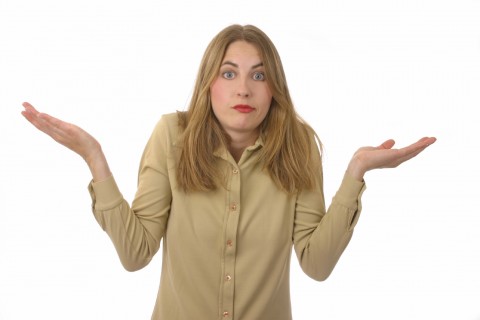
En ole varma. (“I’m not sure.”)
5. FinnishPod101 Can Help You Learn Finnish Faster
In this guide, you’ve learned about the use of body language in Finland. How many of the gestures and expressions do you use in your own home country? Did you spot any cultural differences that surprised you? Naturally, this article only scratches the surface, so grab a Finn if you can and ask them to teach you even more ways to ‘speak Finnish’ with your hands!
At FinnishPod101, we teach you Finnish in ways that will help you use your language skills confidently in the real world! If you’re new to our website, start by exploring the free resources we offer, including our growing library of Finnish vocabulary lists with audio recordings. Or join our MyTeacher program to kickstart your journey to Finnish fluency.













